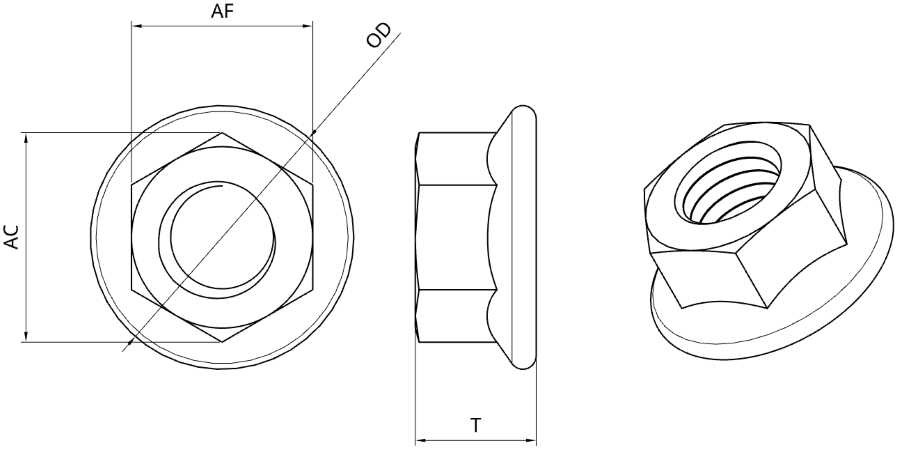Advancements and Challenges in the Galvanization of Flange Nuts for Enhanced Fastener Performance
Flange nuts and general hexagon nuts, while sharing the same size as screw threads, exhibit notable distinctions. In particular, flange nuts integrate gaskets and nuts, featuring an anti-skid insection on the bottom. This design not only increases the surface area contacts between nuts and workpieces but also enhances strength compared to the combination of ordinary nuts and washers.

The Flange Nut Specifications
Common flange nuts typically have specifications below M20. This limitation is primarily due to their predominant use in pipes and flanges, constraining the specifications of flange nuts relative to hexagon nuts. Flange nuts above M20 are often flat flanges without an insection, reserved for specialized equipment and specific applications, making them less commonly stocked by general manufacturers.
Defects in Hot-Dip Galvanizing
Despite their utility, flange nuts pose challenges during hot-dip galvanizing. Several key issues affect the fitness and performance of these fasteners, including:
Benefits of Hot-Dip Galvanizing
Despite the aforementioned challenges, hot-dip galvanizing remains highly regarded in the electric power, communication, and transportation sectors. Its thick coating, robust bonding strength, and long-term corrosion resistance have earned it praise. As China experiences significant development in electric power and transportation, the growth of hot-dip galvanizing for flange nuts is anticipated. This underscores the need for advancements, including the development of automatic centrifugal throwing equipment and improvements in galvanizing processes to enhance the quality of coatings on fasteners.
In the ever-evolving landscape of fastener technology, addressing the defects in hot-dip galvanizing for flange nuts is crucial. The ongoing efforts to enhance the quality and efficiency of galvanizing processes will contribute to the continued success and widespread adoption of these essential components in critical industries.

The Flange Nut Specifications
Common flange nuts typically have specifications below M20. This limitation is primarily due to their predominant use in pipes and flanges, constraining the specifications of flange nuts relative to hexagon nuts. Flange nuts above M20 are often flat flanges without an insection, reserved for specialized equipment and specific applications, making them less commonly stocked by general manufacturers.
Defects in Hot-Dip Galvanizing
Despite their utility, flange nuts pose challenges during hot-dip galvanizing. Several key issues affect the fitness and performance of these fasteners, including:
- Thread Twisting Difficulty: After plating, it becomes challenging to twist the screw thread. Residual zinc in the screw thread is stubborn, affecting the thickness and evenness of the zinc layer. External threads should ideally be processed or rolled before galvanizing, while internal threads can be addressed before or after the process. However, practical considerations often necessitate a galvanized layer on both internal and external threads, requiring creative solutions to avoid compromising fit strength.
- Reduced Mechanical Strength: The high operating temperature of hot-dip galvanizing can diminish the mechanical strength of high-strength flange nuts. Threads on grade 8.8 bolts may fall below standard requirements after galvanizing, and bolts above grade 9.8 struggle to meet strength requirements.
- Environmental Challenges: The hot-dip galvanizing process, conducted at high temperatures, releases irritating hydrogen gas and zinc vapor into the atmosphere. This poses challenges in terms of environmental pollution and poor working conditions.
Benefits of Hot-Dip Galvanizing
Despite the aforementioned challenges, hot-dip galvanizing remains highly regarded in the electric power, communication, and transportation sectors. Its thick coating, robust bonding strength, and long-term corrosion resistance have earned it praise. As China experiences significant development in electric power and transportation, the growth of hot-dip galvanizing for flange nuts is anticipated. This underscores the need for advancements, including the development of automatic centrifugal throwing equipment and improvements in galvanizing processes to enhance the quality of coatings on fasteners.
In the ever-evolving landscape of fastener technology, addressing the defects in hot-dip galvanizing for flange nuts is crucial. The ongoing efforts to enhance the quality and efficiency of galvanizing processes will contribute to the continued success and widespread adoption of these essential components in critical industries.

